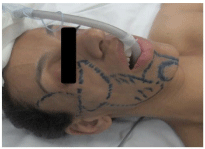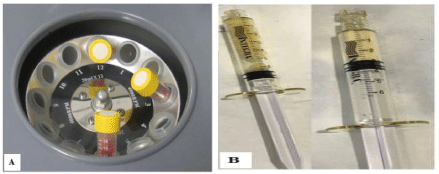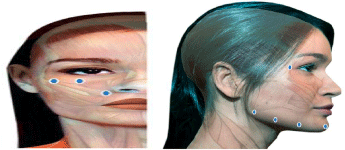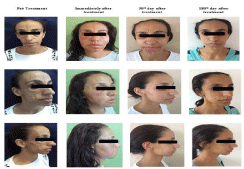
Case Report
Austin Plastic Surg Open Access. 2018; 1(1): 1002.
Parry-Romberg Syndrome, a New Therapeutic Alternative: Case Report
Ruiz RO¹*, Portela DL¹, Gonella HA¹, Pinheiro LF², Rives JM³ and Gerenutti M4
¹Department of Pontifical Catholic University, Sorocaba, SP, Brasil
²Department fo São Paulo´s Red Cross Hospital, SP, Brasil
³Private Practice, Paris, France
4Department the Development and Evaluation of Bioactive Substances, University of Sorocaba, Sorocaba Brasil
*Corresponding author: Ruiz RO, Department of Pontifical Catholic University, Sorocaba, SP, Brasil
Received: March 22, 2018; Accepted: May 04, 2018; Published: May 11, 2018
Introduction
Background: The use of the acellular dermal matrix is already known in traumas of diverse natures, its presentation for the injectable use has helped in the therapy of several pathologies, and one of them is the Parry-Romberg Syndrome (PRS).To present a treatment to facial asymmetry and aesthetic improvement of a patient with the associated treatment of fat graft and injectable dermal matrix.
Case Presentation: One female patient, a carrier of the syndrome for ten years, treated several times without success. This time the acellular dermal matrix was applied in hemiface affected by the pathology, to support the facial middle third and to return the lost volume, on the non-affected side was injected for the best symmetrization.
Conclusion: The result after 180 days remained very acceptable as to the parameter of symmetry, and aesthetic improvement of the patient’s face, there was a great increase in self-esteem. The result with fat graft and dermal matrix remain satisfactory after 180 days.
Keywords: Parry-Romberg Syndrome; Dermal Matrix; Facial Symmetry; Fat Graft
Abbreviations
PRS: Parry-Romberg Syndrome
Background
Hemifacial muscle atrophy or Parry-Romberg Syndrome (PRS) was first described by Calleb Hillier Parry, an English physician, in 1825 and disseminated by Moritz Heinrich Romberg, a German physician, in 1845. It is a rare, autoimmune syndrome which is prevalent in younger than 20 years old patients. It has a slight occurrence in females. No racial distinction was observed [1].
Several signs can be observed in its appearance, which according to the severity can be classified as mild, moderate and severe. These symptoms are diverse, such as skin hardening, mainly above the maxillary region, dyschromic spots on facial or scalp, facial pain, an appearance of white hair. These can progress to bone deformities, poor tooth and gum formation and alopecia. They can get worse and lead to dermal, bony and muscular atrophies. Sometimes it presents intracranial vascular malformations and convulsive conditions, which indicates cerebral compromise [2-8].
Clinical treatment lends itself to control neurological and ocular symptoms, and pharmacotherapeutic treatment seeks better swallowing and phonation. The surgical treatment aims at an aesthetic improvement and correction of the facial asymmetry, and several surgical techniques have been attempted. Dermal, cartilaginous, facial and bone grafts, multiple flap rotation, alloplastic fillers and fat graft may be used [9-12]. Most patients need repeated procedures or fat grafts for the correction of asymmetry.
The dermal matrix, which was described in 1981 by Burke and Yannas [13], consisting of a layer of acellular bovine dermis covered by a silicone blade, being very used to cover uninfected and nonsecretive traumatic lesions, completing the treatment after a few days with partial skin grafting [14-16]. Under went modernization, since 2017 if it has a single presentation layer, where the silicone layer was removed and allows the accomplishment of skin grafting in a single procedure in traumatic injuries or burns [17-23]. Today we have an injectable presentation [24-26]. That can be used to treat facial asymmetry resulting from the described syndrome.
To present a treatment to facial asymmetry and aesthetic improvement of a patient with associated treatment of fat graft and injectable dermal matrix.
Case Presentation
Female patient, 45 years old, presenting Parry-Romberg syndrome for 10 years, with seven fat grafts already performed in the plastic surgery service of Sorocaba, presenting important facial asymmetry. This treatment done in São Paulo’s Red Cross Hospital.
All preoperative exams were performed and were within the parameters of normality. he areas of liposuction were previously marked on the inner side of the thigh and on the face, demarcating the areas to be treated, with continuous lines marking the bony protrusions and between the lines were the areas that would be approached by means of intradermal injections, promoting the Filling, thus recovering the facial volume (Figure 1).

Figure 1: Making of the areas to be treated, the solid lines mark the bony
facial protrusions and between the lines is the area to be treated intradermally
as dermal filler.
With the patient in horizontal dorsal decubitus under narcosis, asepsis, and antisepsis of the entire face, lower limbs and abdominal region were promoted. A liposuction of 40ml fat was performed on the inner thigh surfaces using a 50ml syringe. After centrifugation of the contents of the liposuction, 9ml of pure fat was separated, adding 9ml of the injectable dermal matrix and reserved for later use in the face (Figure 2).

Figure 2: A) Centrifuge with the tubes with aspirated material. B)
Homogenization of fat with the injectable matrix.
Facial treatment began with Bolus injection using microcannula of 2mm in diameter and length ranging from 10 to 15 cm from the pure injectable dermal matrix in the regions of bony protrusion on the side affected by the pathology to promote abutments and mandibular contour, as shown in (Figure 3).

Figure 3: Schematic drawing on photo illustrating the injection points of
the “pure” matrix in Bolus, more deeply, promoting pillar of facial support
and reinforcing the bony protrusions. The fan lines demonstrate how the
intradermal injections of homogenized fat with matrix.
Drawing on photos of Christian Gaul and Roberta Fontelles Philomeno-model
Caroline Ribeiro.
After this maneuver, homogenized fat was used with the matrix as soft part filler, making intradermal injections, in a fan refining the treatment of the middle third. The contralateral side was also treated with fat homogenized with the dermal matrix for an improved symmetrization.
The patient was discharged from hospital 24 hours after the procedure with compressive meshes in the liposuction region, without dressings on the face. Photos of the patient were taken in the pretreatment and serially until the sixth month in which maintenance of the result is observed (Figure 4).

Figure 4: Patient in the pre-treatment and serially until the sixth month in
maintenance of the results.
Discussion and Conclusions
Although rare, Parry-Romberg syndrome is extremely stigmatizing and requires surgical treatment, often in multiple procedures, which increases morbidity. The use of alloplastic material is an option, but the high cost of absorbable materials and the complications in the use of nonabsorbable materials make this practice very difficult.
Translocations of flaps may be necessary in most of the severe cases when is more important local vascular impairment, but morbidity limits the use of this technique, the fat graft is a very used option. However, some patients are very thin, making difficult to obtain the amount of fat for the correction of facial asymmetry, and the possibility of reabsorption of the grafted material, an unpleasant intercurrence, may require repeated procedures for facial symmetry [27-30].
The use of dermal substitutes has been aiding in medical treatments since 1981, mainly in the coverage of traumatic injuries, or treatment of burned patients, as we can see in the works of Burke and Yannas [13]. The development of more modern products, capable of being used in a single time as the single layer or more modern products of injectable use, favor in obtaining good results in use in these patients, expanding also the use for patients with sequelae of surgeries for excision of tumors of the skin, or sequelae of several surgeries, with decreased morbidity and mortality of the procedure [31,32].
In the reported case, fat grafting was associated with the use of injectable matrix and compared to previous bad results with the use of the fat graft. After internal liposuction of thighs, centrifugation and fat homogenization with the dermal matrix, the treatment of facial asymmetry was started. Using the surgical technique indicated by Dr. Jean-Michel Rives, a French surgeon with a great deal of expertise in the use of dermal matrix in the medical field, subdermal abutments were made reinforcing the projection of bony facial protrusions with the “pure“ injectable dermal matrix, A homogeneous mixture of 9ml of pure fat and 9ml of injectable dermal matrix was used in order to, in intradermal injections, fill the hemiface affected by SPR. Filling was performed on the contralateral (unaffected) side for better symmetrization.
Immediately after the procedure, the patient presented an extensive edema, but the volumetric normalization of the face occurred in a relatively short time, the 30-day post-procedure photos showed this standardization. The 6-month follow-up shows the satisfactory and stable outcome. As it is a recent procedure, new studies should be carried out to improve the understanding and evaluate the result.
The use of injectable dermal matrix was shown to be effective and stable as a treatment for facial asymmetry by Parry-Romberg Syndrome in this patient.
Declarations
Authors’ contributions
ROR, DLP. HAG, LFP and JMR: Patient assessment, diagnosis, management. ROR and MG preparation of the manuscript for submission. All authors read and approved the final manuscript.
Acknowledgements
We would like to acknowledge the patient and his family members for the support.
Competing Interests
The authors declare that they have no competing interests.
Availability of data and materials
Data regarding this patient will be available for review in São Paulo’s Red Cross Hospital and is kept under confidential cover.
Consent to publish
Informed written consent form obtained by the patient is available with the corresponding author under confidential cover. Identifying/ confidential patient data were not shared in the case report.
References
- Creus L, Sanchez-Regaña M, Salleras M, Chaussade V, Umbert P. Parry-Romberg syndrome associated with homolateral segmental vitiligo. Ann Dermatol Venereol. 1994; 121: 710-711.
- Duro LA, Lima JM, Reis MM, Silva CV. Progressive hemifacial atrophy (Parry-Romberg disease): Study of a case. Arq Neuropsiquiatr. 1982; 40: 193-200.
- Miedziak AI, Stefanyszyn M, Flanagan J, Eagle RC. Parry-Romberg syndrome associated with intracranial vascular malformations. Arch Ophthalmol. 1998; 116: 1235-1237.
- Duymaz A, Karabekmez FE, Keskin M, Tosun Z. Parry-Romberg syndrome: Facial atrophy and its relationship with other regions of the body. Ann Plast Surg. 2009; 63: 457-461.
- Oliveira LRT, Cronemberger S, Oréfice F. Síndrome de Parry-Romberg associada à uveíte difusa e alterações retinianas. Rev Bras Oftal. 1998; 57: 949-952.
- Palafox D, Gómez CG, Granados J, Barquera R, Ortega-Hernández E, Hernández-Zaragoza DI, et al. Determinación de HLA en pacientes con Síndrome de Parry Romberg atendidos en el Servicio de Cirugía Plástica y Reconstructiva del Hospital General 'Dr Manuel Gea González'. Cir Plast Iber-latinoam. 2016; 422: 115-120.
- Hernández MI, Nicola L, Meik S, Trila C, Kien C, Abeldaño A. Hemiatrofia facial progresiva y morfea en golpe de sable: ¿Entidades diferentes o un espectro de la misma enfermedad? Dermatol Argent. 2014; 20: 391-399.
- Chaves EBF. Main clinical findings in patients with progressive hemifacial atrophy: Parry-Romberg syndrome. Arq Catarin Med. 2013; 42: 76-81.
- Spraker M. Sclerosing and atrophying conditions. In Schachner LA, Hansen RC, eds. Pediatric dermatology. Churchill Livingstone. 1988.
- Alencar JCG, Andrade SHC, Pessoa SGP, Dias IS. Autologous fat transplantation for the treatment of progressive hemifacial atrophy (Parry-Romberg syndrome: case report and review of medical literature. An Bras Dermatol. 2011; 86: 85-88.
- Morais-Besteiro J, Aki FE, Mendes JA, Ferreira MC. Microsurgical transplants for facial depressions. Rev Hosp Clin Fac Med São Paulo. 1992; 47: 271-275.
- Burke JF, Yannas IV, Quinby WC Jr, Bondoc CC, Jung WK. Successful use of a physiologically acceptable artificial skin in the treatment of extensive burn injury. Ann Surg. 1981; 194: 413-428.
- Wartenberg R. Progressive facial hemiatrophy. Arch NeurolPsychiatr. 1945; 54: 75-96.
- Kremer M, Lang E, Berger AC. Evaluation of dermal-epidermal skin equivalentes (‘composite-skin’) of human keratinocytes in a collagen-glycosamynoglycan matrix (Integra™ Artificial Skin). Br J Plast Surg. 2000; 53: 459-465.
- Rafailov L, Turbin, RE, Langer PD. Use of bilayer matrix wound dressing in the exenterated socket. Orbit. 2017; 36: 397-400.
- Lee YJ, Park MC, Park DH, Hahn HM, Kim SM, Lee IJ. Effectiveness of Acellular Dermal Matrix on Autologous Split-Thickness Skin Graft in Treatment of Deep Tissue Defect: Esthetic Subjective and Objective Evaluation. Aesthetic PlastSurg. 2017; 41: 1049-1057.
- Böttcher-Haberzeth S, Biedermann T, Schiestl C, Hartmann-Fritsch F, Schneider J, Reichmann E, et al. Matriderm® 1mm versus Integra® Single Layer 1.3mm for one-step closure of full thickness skin defects: A comparative experimental study in rats. PediatrSurg Int. 2012; 8: 171-177.
- Koenen W, Felcht M, Vockenroth K, Sassmann G, Goerdt S, Faulhaber J. One-stage reconstruction of deep facial defects with a single layer dermal regeneration template. J EurAcadDermatolVenereol. 2011; 25: 788-793.
- Kosutic D, Beasung E, Dempsey M, Ryuan L, Fauzi Z, O’Sullyvan B, et al. Single-layer Integra for one-stage reconstruction of scalp defects with exposed bone following full-thickness burn injury: A novel technique. Burns. 2012; 38:1 43-145.
- Demiri E, Papaconstantinou A, Dionyssiou D, Dionyssopoulos A, Kaidoglou K, Efstratiou I. Reconstruction of skin avulsion injuries of the upper extremity with integra® dermal regeneration template and skin grafts in a single-stage procedure. Arch Orthop Trauma Surg. 2013; 133: 1521-1526.
- Shahrokhi S, Arno A, Jeschke MG. The use of dermal substitutes in burn surgery: Acute phase. Wound Repair Regen. 2014; 22: 14-22.
- Lyons M, Parcells AL, Granick MS. Single-Stage Dermal Matrix and Skin Grafting to Treat a Complicated Hand Wound. Eplasty. 2016; 16: 23.
- Nery ALV, Porter KE, Freire RF, Baptista NS, Baptista NS, Esberad F, et al. New approach to the treatment of complex injuries: The use of dermal regeneration matrix. Rev Bras Queim. 2011; 10: 66-70.
- Debels H, Hamdi M, Abberton K, Morrison W. Dermal Matrices and Bioengineered Skin Substitutes: A Critical Review of Current Options. Plast Reconstr Surg Glob Open. 2015; 3: 284.
- Hirche C, Senghaas A, Fischer S, Hollenbeck ST, Kremer T, Kneser U. Novel use of a flowable collagen-glycosaminoglycan matrix (Integra™ Flowable Wound Matrix) combined with percutaneous cannula scar tissue release in treatment of post-burn malfunction of the hand-A preliminary 6 month follow-up. Burns. 2016; 42: 1-7.
- Später T, Frueh FS, Menger MD, Laschke MW. Potentials and limitations of Integra® flowable wound matrix seeded with adipose tissue-derived microvascular fragments. Eur Cell Mater. 2017; 33: 268-278.
- Neto NF, Martins JWG, Farage Filho M, Henriques FG. Hemiatrofia Facial de Romberg- Relato de Caso. Arq Neuropsiquiatr. 1995; 53: 795-798.
- Mordick TG, Larossa D, Whitaker L. Soft-tissue reconstruction of the face: A comparison of dermal-fat grafting and vascularized tissue transfer. Ann Plast Surg. 1992; 29: 390-396.
- Xie Y, Li Q, Zheng D, Lei H, Pu LL. Correction of hemifacial atrophy with autologous fat transplantation. Ann Plast Surg. 2007; 59: 645-653.
- Slack GC, Tabit CJ, Allam KA, Kawamoto HK, Bradley JP. Parry-Romberg reconstruction: Beneficial results despite poorer fat take. Ann Plast Surg. 2014; 73: 307-310.
- Amaral CER, Denadai R, Buzzo CL, Amaral CAR. Therapeutic appro therapeutic approach to the Parry-Romberg Syndrome based on a severity grading system. Braz J Plast Surg. 2014; 29: 57-65.
- Campitiello F, Della Corte A, Guerniero R, Pellino G, Canonico S. Efficacy of a new flowable wound matrix in tunneled and cavity ulcers: A preliminary report. Wounds. 2015; 27: 152-157.